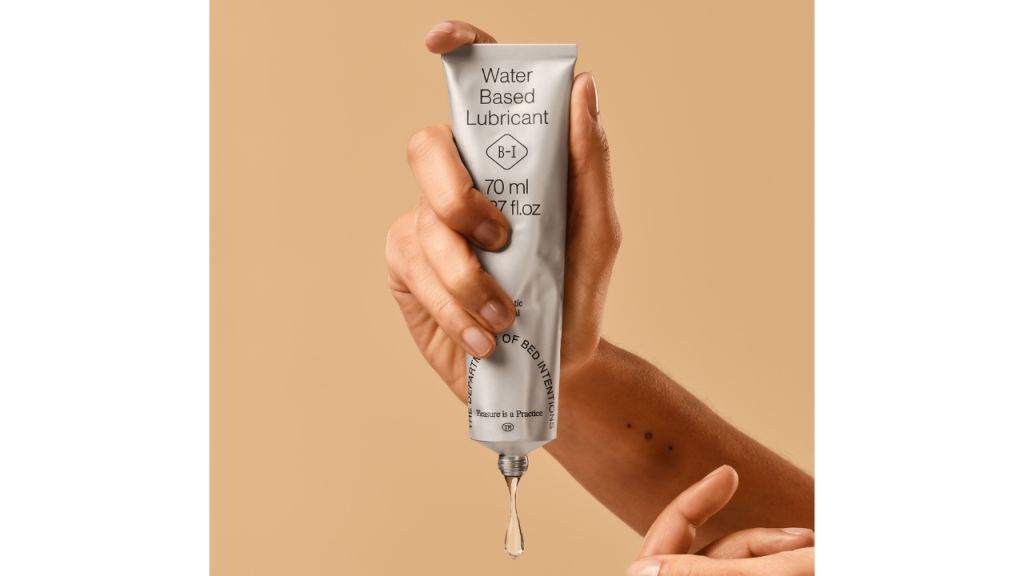Lube probably isn’t something you put a lot of thought into until you well and truly need it. It’s normally just an afterthought product used to slather onto your toys or to make safe sex more enjoyable.
But have you ever ended up with some sort of infection or discomfort (read: thrush or a UTI) after using one? Has a particular lube made your toys feel uncomfortable? Have you noticed your discounted supermarket lubricant has caused more frequent condom breakage?
Well, it turns out finding a body-safe lube goes beyond simply choosing between a water, silicone or oil-based variety, and we should start considering another factor: whether or not a lube is pH-friendly.
Enter: the microbiome-friendly lubricant.
The importance of a lube’s pH level
Australian-based sex and sleep startup The Department of Bed Intentions has released the world’s first microbiome-friendly certified (via MyMicrobiome) water-based lubricant. The $35 product – which is also completely plastic-free and certified cruelty-free – came about after founder Sophie McGrath experienced a bout of irritations and imbalances caused by the lubes she was using.
“The reason I decided to create a lubricant was because I started to pay attention to the reactions and symptoms of the lubricants I was previously using and they always left me with some sort of irritation or imbalance,” McGrath told Lifehacker.
“Unfortunately, I don’t think enough care has been taken to design lubricants that are truly safe and healthy for the body.”

According to Healthline, some lubricants made with harmful – and unfortunately, common – ingredients can provoke side effects like swelling (especially the face, tongue and throat), hives, rash, itchiness and yeast infections.
But equally as important as steering clear from toxic ingredients is understanding that the pH level of the tube in your bedside drawer should ideally range between 3.8 and 5 to keep bacteria and fungal infections at bay.
“Lubricants should be compatible with a healthy pH of the vagina, and sadly, many commercially available lubricants have pH levels too high, which increases an individual’s risk of infection such as thrush and UTIs,” McGrath stressed.
So, McGrath spent three years working with scientist and formulator Wanda Chin, to create a prebiotic-packed lubricant that can maintain the user’s natural microbiome balance and pH levels — and medical experts are on board with this new variety of lube, too.
“A ‘microbiome-friendly certified’ lube may provide benefits by supporting a healthy vaginal microbiome,” medical doctor and clinical sexologist Dr Jessica Wade confirmed with Lifehacker. “Ingredients like prebiotics and pH-balancing components can contribute to maintaining optimal microbial balance.”
According to Dr Wade, the benefits of using this type of lube go beyond avoiding any unwanted side effects.
“Hypoallergenic and pH-balanced formulations can enhance safety and comfort during intimate activities.” So, yes, steamier sex sessions.
What are the different types of lube?
Water-based lube
This is the most popular variety on the market and can be formulated with or without glycerin (a natural moisturiser derived from oil or animal fat).
While safe to use with condoms and other forms of birth control, the sugar content in glycerin water-based lubes can contribute to yeast infections and some varieties can cause deterioration of skin cells in the vulva.
Our advice? Fork out a few more dollars for a water-based lubricant made without glycerin.
Silicone-based lube
This type of lube is generally more expensive than water-based ones as it lasts longer, is safe for use with latex condoms and can withstand water (hello, shower sex). However, the residue is harder to wash off, and they’re not compatible with silicone sex toys.
While safe for most individuals, it won’t take long to notice if you are allergic to silicone.
Oil-based lube
Synthetic oil-based lubes should be a last resort.
In fact, Dr Wade refers to oil-based lubes as “an alternative” because they do come with “higher rates of irritation and potential infection risks, plus, they’re not comparable with latex condoms and latex toys.”
What are the most harmful lubricant ingredients?
Just like you’d maybe scan through the food label of something you’re about to eat, you should get acquainted with knowing your lube ingredients.
Ingredients to steer clear of include the following:
- Petrolatum
- Petroleum jelly
- Microbicide nonoxynol-9
- Glycerin
- Preservatives (including parabens and citric acid)
- Propylene glycol
- Benzene
- Benzoic acid
- Chlorhexidine
- Benzocaine
So, what ingredients should you look for in a body-safe lube?
Dr Wade says plant-based ingredients are a positive tell-tale sign a lube won’t cause havoc, as are products labelled free from gluten, fragrances, dyes and flavours.
“Look for lubes with body-friendly ingredients like aloe vera, chamomile or vitamin E.”
For example, the Bed Intentions Water Based Lubricant is formulated with skin-loving ingredients like green tea, fermented cranberry and Camellia Sinensis extract, making it void of gluten, sugar, hormones, glycerin and parabens.
Other organic ingredients you’ll want in a body-safe lube include flaxseed extract, carrageenan, quinoa, hemp and oat extracts.
How to choose the right body-safe lubricant for you
Everyone’s lubricant needs vary depending on an array of factors.
Are you looking for one that’s compatible with silicone sex toys? Will you be using a condom? What ingredients agree and disagree with your genitals?
While you’ll need to consider questions like these, just remember the following: “Prioritise lubes with natural, body-friendly ingredients and avoid potential irritants,” Dr Wade concludes. TBH, this is a big reason why we’ll probably start seeing more microbiome-friendly varieties popping up.
It’s also best to test out a lube before going all in. This can be done by applying some on your wrist or inner elbow. If the test patch goes well, you can then test a small amount on and around the vulva to see how you react in more sensitive areas.
And the moment you notice any unusual sensations, “cease use immediately”.
“Wash the affected area with water and if symptoms persist, consult a healthcare professional,” Dr Wade urged.
Ultimately, settling on the right lube for you will need some experimenting. But we assure you that once you find a lube that you and your body enjoy, pleasure time will become even more enjoyable and steamier for everyone involved.
The Bed Intentions Water Based Lubricant is available online for $35.
Lead Image Credit: Credit: Bed Intentions/Sex Education

Leave a Reply
You must be logged in to post a comment.